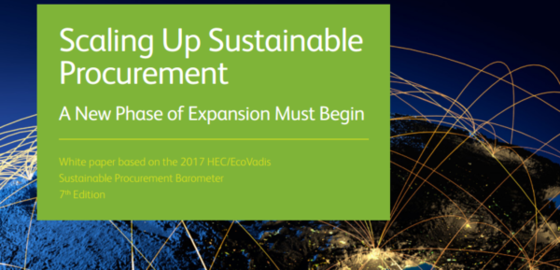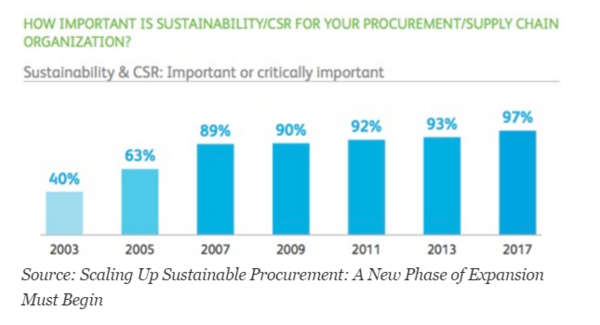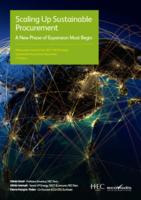The State of Sustainable Procurement: Latest EcoVadis/HEC Paris Barometer is Released
HEC Paris and EcoVadis released its seventh and latest Sustainable Procurement Barometer on Tuesday, a joint study on supply chain sustainability that was first carried out over a decade ago. These studies measured sustainable procurement practices in global procurement organizations and aimed to provide a landscape view, including “sector and geographical differences, industry strengths, improvement areas [and] new frontiers for innovation.”

The importance of sustainable procurement (SP) continues to grow rapidly. No longer seen as a nice-to-have discipline, SP has evolved into an integral business function responsible for reducing costs, mitigating business risk, protecting and improving brand reputation, driving revenue, and supporting innovation and growth.As a result, Fortune 500 organizations across the globe are investing heavily to ensure sustainability is ingrained across all aspects of their supply chain and procurement operations. The challenge – especially for chief procurement officers (CPO) and chief sustainability officers (CSO) - is to ensure the investment pays off and has the desired impact across the supply chain in accordance with CEOs’ and top managers’ expectations.
Since the first study carried out over 10 years ago (2003) by Professor Olivier Bruel, the HECParis/EcoVadis Sustainable Procurement Barometer has measured the evolution of SP practices in global procurement organizations. The last Barometer, published in 2013 and titled “Time To Measure Value Creation”, found global organizations struggling to harness the attention and support of top management and lacking solid footing around performance metrics and objective setting.
For the 2017 report, titled “Scaling Up Sustainable Procurement: A New Phase of Expansion Must Begin,” EcoVadis and HEC surveyed 120 companies spread across industry sectors. In addition, 360 suppliers were surveyed this year in order to gather data and insights from the supplier perspective.The last Barometer study was published in 2013, and it found that global organizations were struggling to get the support of top management and lacked “solid footing” where performance metrics were concerned.
Numbers from the 2017 Barometer, however, look a bit different.
Sustainability Becomes a Top Priority
Both in 2013 and in 2017, procurement cited cost savings, compliance and risk reduction as their top three priorities. However, the percentage of procurement organizations saying that compliance is “critical” has increased sharply from 27% to 55%. The report points to regulations such as the Dodd-Frank Act on Conflict Minerals and the U.K. Modern Slavery Act in explaining this change.
Sustainability and corporate social responsibility (CSR) has also edged up in importance. In 2013, 18% of procurement organizations considered it a “critical” priority, compared with 23% in 2017.

As you can see above, sustainability and CSR have steadily grown in perceived importance, with 97% of the procurement organizations surveyed considering them important or critically important.
Also interesting is the finding that the main sustainable procurement driver in the United States is risk mitigation, whereas in Europe it is brand reputation. In addition, labor and social issues have begun to receive more attention, compared to environmental issues in the first half of this decade. Whereas only 18% of the surveyed organizations are placing “significantly more importance” on the environment today than they were three years ago, that figure jumps to 33% when it comes to social and labor issues or business ethics.
Companies Care. Now What?
So we’ve established that sustainable procurement is valued. But has that translated into results? (For we know that caring about ethical sourcing doesn’t necessarily affect consumer behavior.)
The answer is yes, with a caveat. The 2017 Barometer found that 45% of surveyed organizations reported that their sustainable procurement program covered more than 75% of volume spend with their strategic supplier base. This is an increase from 27% in 2013. This is all good news, though the caveat is that “big spend” suppliers are already “more scrutinized and present far lower risks. It is often in the ‘tail spend’ where there are many ‘small volume spend’ suppliers who present significant risks.”
The story is similar when it comes to supply chain visibility. While 66% can boast complete visibility into the sustainability and CSR performance of their tier-one suppliers, only 15% can claim so for both tier-one and tier-two suppliers. A mere 6% claimed full visibility into tier-three suppliers and beyond.As one of the study participants from a top 5 pharmaceutical company said, “Multi-tier visibility and traceability to the origins of our supply chains and transparent reporting on this to our stakeholders is rapidly becoming a requirement for us. It is an extreme challenge. Many in our tier two are not even known to us, and we are at tier six, seven and eight for some of our raw materials.”
Some other interesting data from the 2017 Barometer are as follows:
• 67% of surveyed organizations have a sustainable procurement champion, compared to 44% in 2013
• 38% take sustainable procurement into account when looking at individual performance objectives and appraisals
• 75% use CSR data when picking new suppliers
• 58% use CSR data in annual supplier evaluations
• 47% use third-party supply sustainability databases or scorecards
• Lack of internal resources and difficulty tracking supplier sustainability performance are the top two obstacles against sustainable procurement
• 76% reported improved brand reputation as a result of sustainable procurement programs, and 55% reported better supplier relationships
Recommendations
In short, companies worldwide are now investing in sustainability practices across the supply chain, and sustainable procurement has become vital for revenue and costs, risk mitigation, brand reputation, and innovation and growth. The challenge for chief procurement officers and chief sustainability offers now is to make sure that the investments pay off and produce the desired results.
EcoVadis and HEC have four recommendations for procurement organizations working on their sustainability:
• Have quality external reporting on supply chain and supplier performance. This is essential for supply chain transparency.
• Be patient and persistent. It can take upwards of five years for sustainable procurement programs to bring in benefits such as increased revenue and improved brand reputation.
• Find tools with efficiencies of scale, as the long tail of smaller suppliers can still pose significant risks.
• Get good at supplier relationship management. Collaborate with suppliers in setting performance targets and improvement plans.
This “field” empirical research has been conducted – through a partnering collaboration begun in 2007 - by:
Olivier Bruel, Professor Emeritus HEC Paris
Olivier Menuet, Senior VP Energy, SNCF, & Lecturer HEC Paris (MSc Sustainability and Social Innovation)Pierre-François Thaler,
Co-Founder & Co-CEO, Ecovadis
EcoVadis is the leading collaborative platform world-wide providing sustainability ratings and performance improvement tools for global supply chains
Read the full report, “Scaling Up Sustainable Procurement: A New Phase of Expansion Must Begin,” here.
